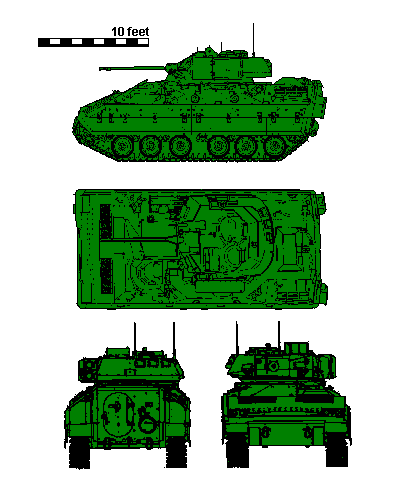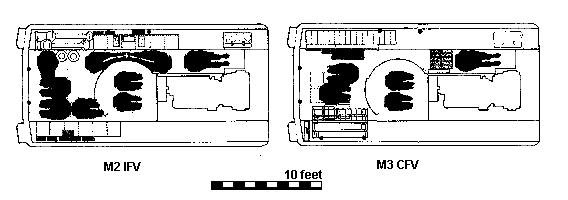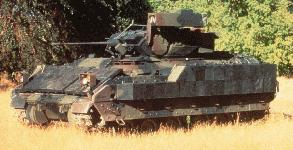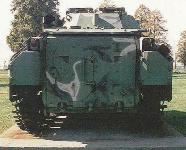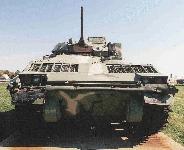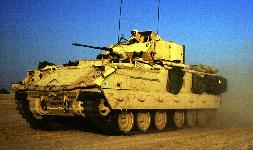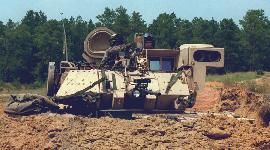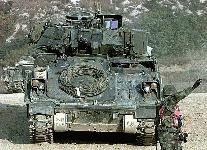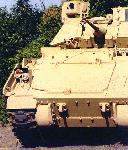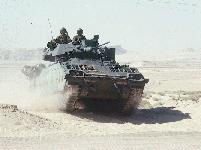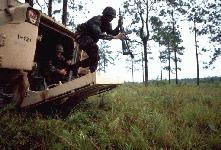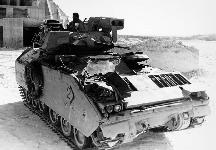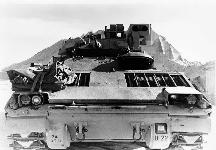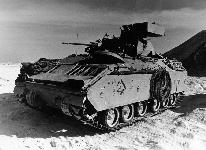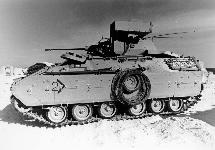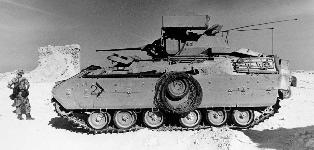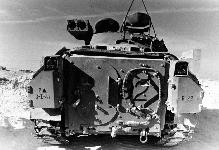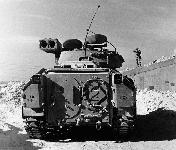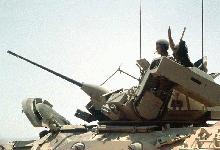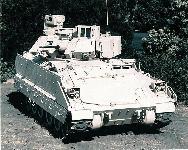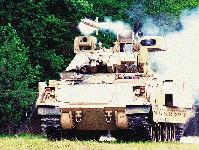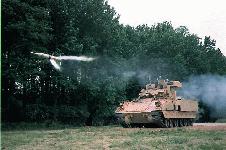The mission of the Bradley Fighting Vehicle [BFV] is to provide mobile protected transport of an infantry squad to critical points on the battlefield and to perform cavalry scout missions. The BFVS will also provide overwatching fires to support dismounted infantry and to suppress or defeat enemy tanks and other fighting vehicles. The Bradley Fighting Vehicle is a fully armored, fully tracked vehicle designed to carry Mechanized Infantry into close contact with the enemy. It possesses sufficient cross-country mobility to keep up with the Abrams Main Battle Tank, medium and long-range firepower capable of defeating any vehicle on the battlefield, and is adequately armored to protect the crew from artillery and small arms threats. During World War II, the vehicle's namesake, General Omar Bradley, was known as the "GI General".
The Bradley is able to close with and destroy enemy forces in support of mounted and dismounted Infantry and Cavalry combat operations. The Bradley Fighting Vehicle family currently consists of two vehicles: the M2 Infantry Fighting Vehicle and the M3 Cavalry Fighting Vehicle. Just as with its predecessor, the M113 family, the Bradley will eventually be the platform for a wide range of support vehicles.Unlike the M113 family of vehicles the Bradley replaces, this is not simply a "battle taxi". The Bradley is a sophisticated weapons platform capable of providing tremendous firepower in direct support of the Infantry it carries. The role of the Bradley is to
- Safely transport Infantry to critical locations on the battlefield
- Provide fire support to cover their dismounted operations, and
- Destroy enemy tanks and other vehicles that may threaten the Infantry it carries
The M2 Infantry Fighting Vehicle [IFV] is a fully tracked, lightly armored vehicle that offers significant improvements over the M113 series of armored personnel carriers. The M2 posses greater power, greater acceleration, and an advanced suspension for a significant increase in cross-country speed. Like the M113, the primary purpose of the M2 is to carry infantryman on the battlefield, and transport and support them with fire if necessary. The M2 Bradley carries a crew of three (Commander, Gunner & Driver) and a six-man Infantry section into combat.
The M3 Cavalry Fighting Vehicle [CFV] is exactly the same chassis as the M2 IFV with some minor internal differences. The M3 is a cavalry/scout vehicle, instead of carrying 6 dismounts in the payload compartment, the M3 carries a pair of scouts, additional radios, ammunition, and TOW and Dragon or Javelin missile rounds. In fact, the only noticeable differences between the M2 and the M3 are that the external firing ports for the squad M16s are absent on the M3.By the end of 1994 the Army had produced a total of 6,724 Bradleys, 4,641 in the M2 Infantry configuration and 2,083 in the M3 Cavalry configuration. Three versions of the M2/M3 have been procured: 2,300 "basic," or A0 Bradleys; 1,371 A1 Bradleys which incorporates the TOW 2 missile subsystem; and 3,053 A2 "high survivability" vehicles. Currently, the Army is conducting depot conversion of A0 and A1 Bradleys to the A2 configuration, modifying 1,423 A2s to the A2 ODS configuration, and preparing to upgrade 1,602 A2s to the A3 configuration. M2/3A0s and A1s will continue to be upgraded to the A2 configuration in FY96. Selected M2/3A2s will be modified with the ODS upgrade pachage through FY02. The First Unit Equipped (FUE) for the A2 ODS variant was FY96. The M2/3A3 vehicle configuration is in EMD with FUE scheduled for FY00.
The M2A3 and M3A3 Bradley Fighting Vehicle Systems (BFVS) are improved versions of the M2A2 and M3A2 BFVS. The BFVS-A3 includes enhancements intended to improve lethality, mobility, survivability, and sustainability. Additionally, these enhancements are intended to provide increased situational awareness and digital command and control capabilities necessary to provide information superiority to the dominant maneuver force. The Bradley Fighting vehicle and the Abrams Tank are the two central components of the dominant maneuver digital force.
The M2A3/M3A3 model of the Bradley will facilitate enhanced command and control, greater lethality, and provide mobile protected transport of an Infantry squad, and Cavalry crewmen to critical points on the battlefield. M2A3/M3A3 will facilitate mechanized Infantry, cavalry scout, and other claimant (Bradley equipped Fire Support and Stinger Teams) missions in the 21st Century. Upgrades include advanced technology in the areas of command and control, lethality, survivability, mobility, and sustainability required to defeat current and future threat forces while remaining operationally compatible with the Abrams main battle tank. The M2A3/M3A3 will provide overwatching fires to support the dismounted infantry and suppress/defeat enemy tanks, reconnaissance vehicles, IFVs, armored personnel carriers, bunkers, and attack helicopters. In the Cavalry role, it will be used to conduct reconnaissance operations, economy of force, and screening missions. It will be employed in Combined Arms units alongside the M1A1 D and M1A2 SEP tank.
The A3 upgrade to the Army’s Bradley fighting vehicle system is a major component of the Army digitization initiative, designed both to complement the capabilities provided by the M1A2 SEP and to incorporate needed enhancements identified during the Gulf War. The M2A3/M3A3 will be equipped with a digital electronic architecture incorporating on-board subsystem monitoring, diagnostics/ prognostics, and an Army Technical Architecture (ATA) compliant Command and Control software suite that is fully interoperable with M1A2 SEP and M1A1 D tanks, and other Force XXI digitized platforms. When equipped with upgraded Bradleys, mechanized infantry units will be able to share battlefield data with M1A2 SEP-equipped armor units. The digitization upgrades will improve both situational awareness and sustainability through automated fault reporting and diagnostics. The A3 upgrade will also increase the lethality of the Bradley by adding an improved fire control system and a commander’s independent thermal viewer. BFVS-A3 enhancements include
- a vehicle control and operation system to control and automate many crew functions and to enhance situational awareness by transmitting, receiving, storing, and displaying digital messages. This digital capability is to be compatible with all components of the combined arms team.
- the improved Bradley acquisition system (IBAS) and commander's independent viewer, both 2nd generation FLIR's, to improve target acquisition and target engagement.
- a position navigation system with GPS receiver to enhance situational awareness.
Approximately 1,602 Bradley A2s will be remanufactured into A3s, including fire support and air defense derivatives. Engineering and manufacturing development of the A3 upgrade will continue through FY 1999. In March 1994, the Army awarded a contract to United Defense, Limited Partnership, to begin the engineering and manufacturing development phase. In June 1997, the Army approved the first LRIP for 35 systems with an FY98 option for an additional 18 systems, and low-rate production began in July 1997. A subsequent LRIP decision is scheduled for FY99 for 78 systems. The IOT&E for the BFVS-A3 is scheduled for 3/4QFY99. This IOT&E will be conducted in conjunction with the FOT&E 3 for the M1A2 Abrams System Enhancement Program. The LFT&E is scheduled for 3QFY98 through 1QFY99. The full rate production milestone decision is scheduled for 1QFY00.
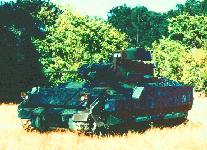 The hull of the Bradley is constructed of welded aluminum and supplemented at critical locations by spaced laminate armor. The latest version of the Bradley, the M2A2, has additional applique steel armor to help defeat ballistic ammunition, with provision for explosive reactive armor for increased protection against shaped charge weapons.
The Applique armor tile system is designed to increase the survivability of the Bradley Fighting Vehicle System (BFVS) against shaped-charge threats using reactive armor technology. Information regarding the specific mechanism of operation and threat level is classified SECRET. A Bradley vehicle set of armor tiles consists of 105 tiles in the following quantities: 26 M3A1, 9 M4A1, 55 M5A,1 7 M6A1, and 8 M7A1. The armor tiles were subjected to comprehensive technical testing and evaluation during Phase II (screening tests) and Phase III (performance specification qualification tests). The coordinated test plan for this evaluation was
formulated by AMSAA, TECOM, CSTA, PM - Bradley, and ARDEC. The testing has demonstrated the tiles are safe
and meet the performance requirements.
The hull of the Bradley is constructed of welded aluminum and supplemented at critical locations by spaced laminate armor. The latest version of the Bradley, the M2A2, has additional applique steel armor to help defeat ballistic ammunition, with provision for explosive reactive armor for increased protection against shaped charge weapons.
The Applique armor tile system is designed to increase the survivability of the Bradley Fighting Vehicle System (BFVS) against shaped-charge threats using reactive armor technology. Information regarding the specific mechanism of operation and threat level is classified SECRET. A Bradley vehicle set of armor tiles consists of 105 tiles in the following quantities: 26 M3A1, 9 M4A1, 55 M5A,1 7 M6A1, and 8 M7A1. The armor tiles were subjected to comprehensive technical testing and evaluation during Phase II (screening tests) and Phase III (performance specification qualification tests). The coordinated test plan for this evaluation was
formulated by AMSAA, TECOM, CSTA, PM - Bradley, and ARDEC. The testing has demonstrated the tiles are safe
and meet the performance requirements.



